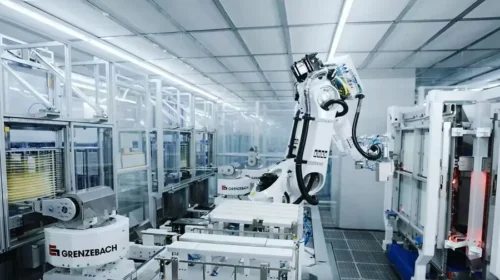Ganfeng Lithium Profit Soars on Skyrocketing Prices, as Company Moves Into Batteries

The lithium producer is moving aggressively to integrate its supply chain, as exploding demand for new energy batteries fuels its profits
Key takeaways:
- Ganfeng Lithium said its profit last year surged as much as 4.37 times on soaring lithium prices
- Company’s new battery-related projects and new production capacity could provide important future growth engines
By Fai Pui
Sometimes known as “white oil”, lithium is probably the most talked-about periodic table element in financial markets lately. You are also probably no stranger to it, either. Given how important it is for the production of new energy vehicle batteries, people in the Chinese car industry like to joke that electric battery makers holds the purse strings of electric vehicle (EV) makers. But raw material makers are the mother of all purse string holders, as they supply the battery makers.
The Covid-19 pandemic has forced many lithium mines to be shuttered. But demand for lithium compounds has surged in the meantime as the global transition to clean energy drives up demand for EVs. That has dramatically driven up the cost of lithium.
The price of SMM battery-grade lithium carbonate was between 345,000 yuan ($54,250) and 353,000 yuan per ton between Jan. 17 and Jan. 21 this year, compared to 68,000 yuan and 76,000 yuan per ton last January – representing a more than fourfold increase, according to the website of Shanghai Metals Market (SMM), a provider of information on nonferrous metals.
One of the largest beneficiaries has been lithium compounds producer Ganfeng Lithium Co. Ltd (1772.HK; 002460.SZ). The company estimated that it made a killing last year, to the tune of a profit between 4.8 billion to 5.5 billion yuan, representing a year-on-year increase of 3.68 to 4.37 times.
The company pointed to several factors behind its rising fortunes. Most importantly, rapid growth of the new energy vehicle and energy storage sectors is fueling downstream demand for lithium compounds, helping to pump up the company’s production and sales of those compounds. Aided by rising prices and expansion of its capacity with new projects, its revenue and profit naturally took off. Valuation adjustments for its financial holdings also played a role, adding to its non-recurring revenue last year.
Still, the explosive growth owes largely to fast-rising demand for lithium batteries of all types.
The market used to sum up Ganfeng’s business model as simply “buying lithium and selling lithium compounds”. But Chairman Li Liangbin has always known that his company must control its entire supply chain to win in the market, and is determined to take the fight directly to the biggest electric battery maker in China.
Zeng Yuqun, the head of leading Chinese battery maker Contemporary Amperex Technology (300750.SZ), also known as CATL, is also acutely aware of the importance of lithium as the lifeline for any downstream battery maker. So, he can’t afford to let others dictate the supply of lithium available to his company, especially in the current environment of undersupply.
That tension underpinned a fierce tussle between the two men last year in the scramble to acquire Millennial Lithium (ML.V), a Canadian company that develops new lithium mines. Ganfeng first approached the company last July for a possible acquisition. But two months later CATL tried to derail the deal by offering more.
In the end the Canadian company chose neither, going with Lithium Americas (LAC.US) last November at a price of $400 million (2.54 billion yuan), 35% higher than CATL’s offer. But Ganfeng still came out as a winner of sorts, since it is part owner of Lithium Americas, which is a joint venture.
As a midstream business in the lithium supply chain, Ganfeng has been relentless in its search for new lithium mines in recent years. Its accomplishments include access to mines in Mount Marion and Pilbara Pilgangooora in Australia, Avalonia in Ireland and Ningdu County of China’s Jiangxi province, as it tries to increase its raw material self-sufficiency and reduce cost pressures brought by rising global lithium prices.
Battery ambitions
One of the biggest questions for the company is how it will fare as it enters the downstream battery business. In that regard, its interim financial report last year shows it has more than 20 products in five major categories (consumer electric batteries, small polymer cells, solid lithium batteries, lithium power batteries and energy storage batteries). It also owned six lithium battery R&D and production bases, and its products are used in many other products like electric buses, airport equipment, solar storage equipment, smart homes, 5G communications equipment and medical equipment.
Its revenue from the lithium battery business was only 767 million yuan in the first half of last year, representing just 18.9% of total revenue. But it registered yearly growth of 83.7%, indicating its potential to become the new major growth engine in the future.
In one noteworthy feat last year, the company signed a three-year contract to supply global EV leader Tesla (TSLA.US) with battery-grade lithium hydroxide, adding an important new piece to ensure its future financial success.
Most major brokerages are upbeat about the company. Daiwa Securities believes lithium prices will continue to climb this year and the company’s long-term contracts will boost its profits. It has rated the company a “buy,” and boosted its target price from HK$215 to HK$230. China Galaxy Securities also thinks the company’s upstream resource development and breakthroughs in solid battery production downstream are accelerating its development of a comprehensive lithium ecosystem, leading it to maintain its “recommended” rating.
“Lithium is the essential ingredient for EV battery production now and will drive continual growth in the lithium industry,” said Kenny Wen, a commentator at Everbright Sun Hung Kai Co. Ltd. “Ganfeng’s consistent investment in lithium mines is a significant step that will help the company achieve greater self-sufficiency and reduce costs. It has successfully renewed contracts with downstream businesses, which has given its stock a boost, as the share price has support at $110 and still has room to go up, I’m optimistic about it.”
The company’s forecast earnings per share (EPS) range in its latest profit alert translates to a price-to-earnings (P/E) ratio between 25.8 times and 29.7 times. That compares with estimated P/E ratios for Tianqi Lithium (002466.SZ) and CATL of 154 times and 120 times, respectively, showing Ganfeng is quite cheap at the moment.
The Chinese State Council published a document on Monday outlining plans for energy conservation and emissions reduction during the 14th five-year plan period (2021-2025). It has set the goal of having EVs account for 20% of total vehicle sales by 2025. Analysts estimate China’s yearly EV sales will reach 6 million by that point, given last year’s sales of 3.55 million, translating to an annual compound growth rate of more than 14% over the next four years. That bodes quite well for demand for lithium compounds and batteries, which could in turn serve Ganfeng very well.
To subscribe to Bamboo Works free weekly newsletter, click here






